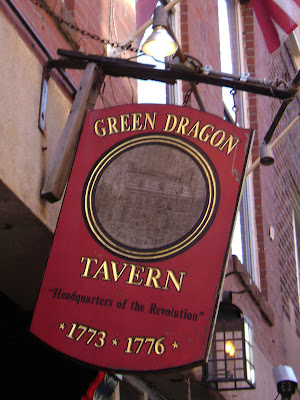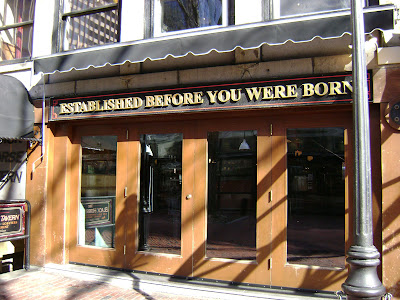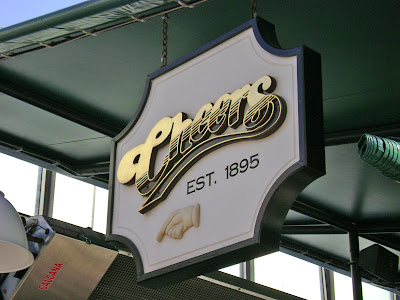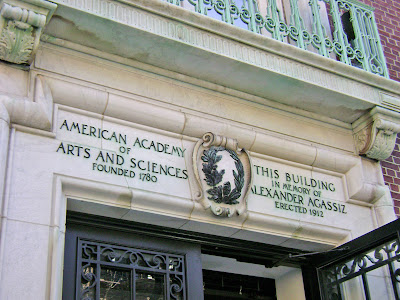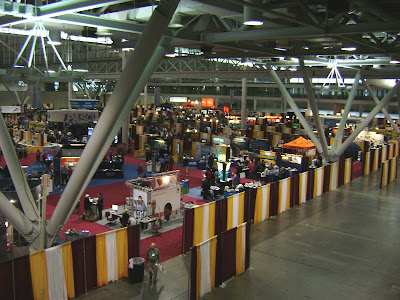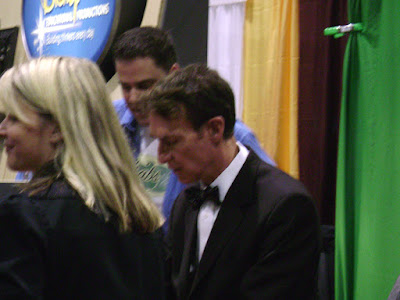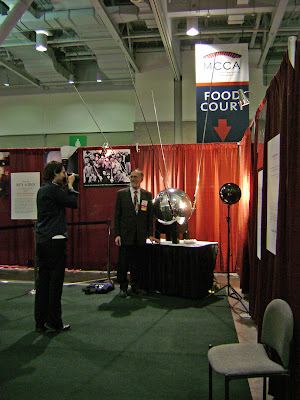So naturally I figured the geoblogosphere could use some posters of their own. Maybe I'll make this a Sunday thing, since I can never remember to do a Friday Field Foto.
Here's Geo Insights poster #1!
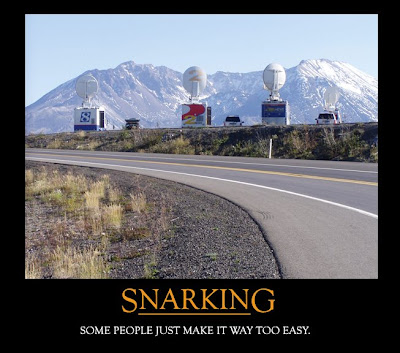

 So, driving to work this morning, I happened to hear one of the ubiquitous "Americans are facing financial hardships because of rising gas prices" reports. And this time, instead of growling at the radio and switching to the classic rock station, I laughed. Because no matter how many times I hear this, I'm still astonished at how self-centered and ignorant of the rest of the world that Americans can be sometimes.
So, driving to work this morning, I happened to hear one of the ubiquitous "Americans are facing financial hardships because of rising gas prices" reports. And this time, instead of growling at the radio and switching to the classic rock station, I laughed. Because no matter how many times I hear this, I'm still astonished at how self-centered and ignorant of the rest of the world that Americans can be sometimes.| Nation | City | Price in USD Regular/Gallon |
| Netherlands | Amsterdam | $6.48 |
| Norway | Oslo | $6.27 |
| Italy | Milan | $5.96 |
| Denmark | Copenhagen | $5.93 |
| Belgium | Brussels | $5.91 |
| Sweden | Stockholm | $5.80 |
| United Kingdom | London | $5.79 |
| Germany | Frankfurt | $5.57 |
| France | Paris | $5.54 |
| Portugal | Lisbon | $5.35 |
| Hungary | Budapest | $4.94 |
| Luxembourg | $4.82 | |
| Croatia | Zagreb | $4.81 |
| Ireland | Dublin | $4.78 |
| Switzerland | Geneva | $4.74 |
| Spain | Madrid | $4.55 |
| Japan | Tokyo | $4.24 |
| Czech Republic | Prague | $4.19 |
| Romania | Bucharest | $4.09 |
| Andorra | $4.08 | |
| Estonia | Tallinn | $3.62 |
| Bulgaria | Sofia | $3.52 |
| Brazil | Brasilia | $3.12 |
| Cuba | Havana | $3.03 |
| Taiwan | Taipei | $2.84 |
| Lebanon | Beirut | $2.63 |
| South Africa | Johannesburg | $2.62 |
| Nicaragua | Managua | $2.61 |
| Panama | Panama City | $2.19 |
| Russia | Moscow | $2.10 |
| Puerto Rico | San Juan | $1.74 |
| Saudi Arabia | Riyadh | $0.91 |
| Kuwait | Kuwait City | $0.78 |
| Egypt | Cairo | $0.65 |
| Nigeria | Lagos | $0.38 |
| Venezuela | Caracas | $0.12 |
Many European nations tax gasoline heavily, with taxes making up as much as 75 percent of the cost of a gallon of gasoline, said a spokesperson for AirInc.And these prices are from three years ago.
In a few Latin America and Middle-East nations, such as Venezuela and Saudi Arabia, oil is produced by a government-owned company and local gasoline prices are kept low as a benefit to the nation's citizens, he said.
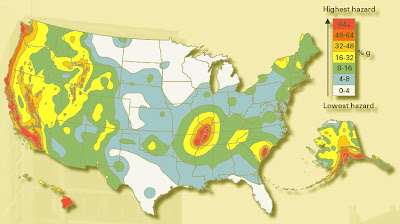 (Image from the 2008 USGS Fact Sheet)
(Image from the 2008 USGS Fact Sheet) Hydrothermally deposited quartz veins in the metagraywacke. Some of these can contain gold - there was even a gold mine in the park area from 1865 to 1940.
Hydrothermally deposited quartz veins in the metagraywacke. Some of these can contain gold - there was even a gold mine in the park area from 1865 to 1940. 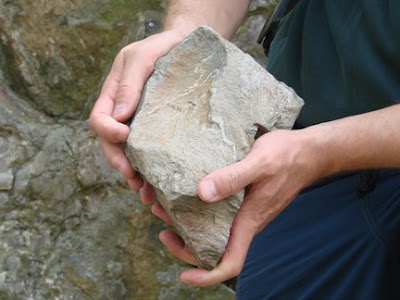
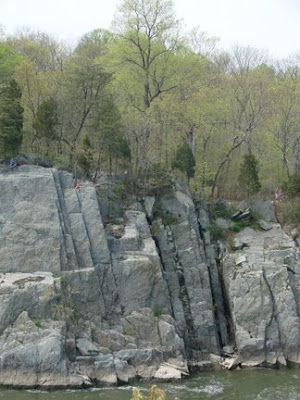

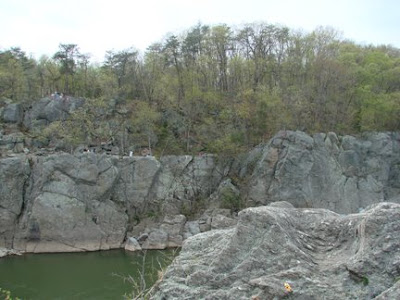
 This particular boulder is really neat, because it contains quartz-filled amygdules (not vugs, thanks for reminding me, Callan! It's amazing what I can forget in a year...). The amygdules show that the basalt was originally vesicular; they managed to survive the metamorphism and get filled with quartz (and maybe some calcite?) later on. Original flow features, yay!
This particular boulder is really neat, because it contains quartz-filled amygdules (not vugs, thanks for reminding me, Callan! It's amazing what I can forget in a year...). The amygdules show that the basalt was originally vesicular; they managed to survive the metamorphism and get filled with quartz (and maybe some calcite?) later on. Original flow features, yay!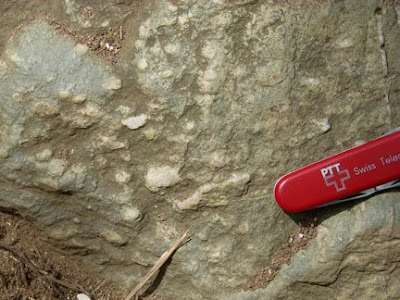
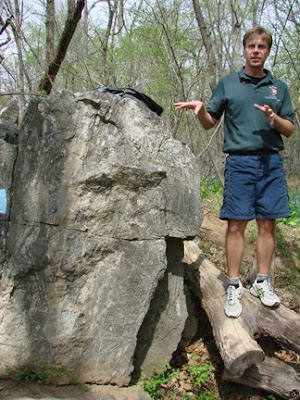
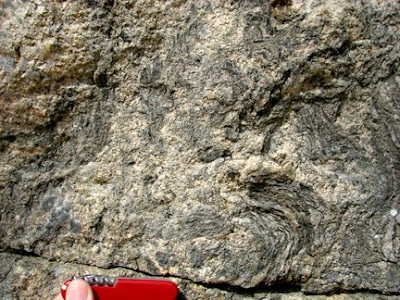
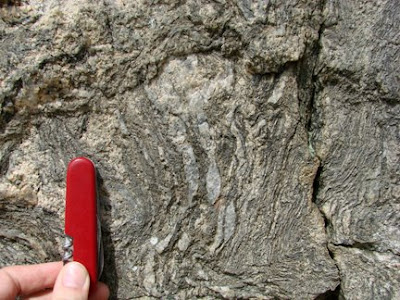
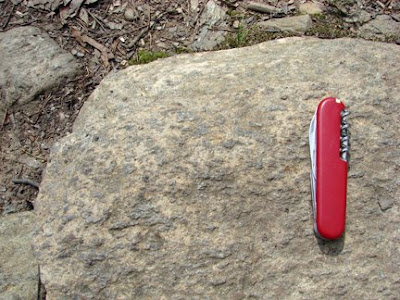

 A view of the
A view of the
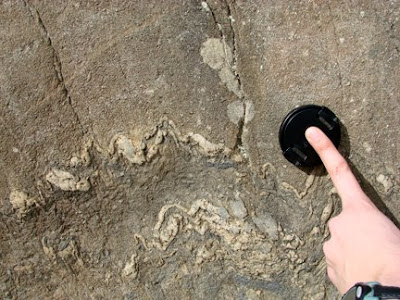
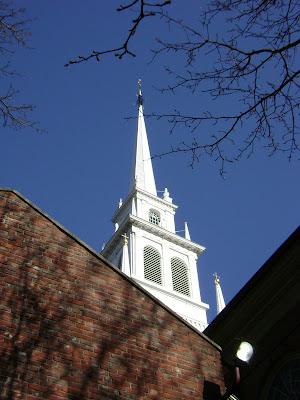 Just as you cross out of the North End (going over the I-93 tunnel), there's a nice little park between Cross Street and Surface Road. And in that park, they have lots of paving stone. It's really pretty, too, and worth the staring when you sit down in the middle of the sidewalk to get a better look at it. (This one's pretty big, about 3x4 feet.)
Just as you cross out of the North End (going over the I-93 tunnel), there's a nice little park between Cross Street and Surface Road. And in that park, they have lots of paving stone. It's really pretty, too, and worth the staring when you sit down in the middle of the sidewalk to get a better look at it. (This one's pretty big, about 3x4 feet.) Whee, isoclinal folding! Not migmatites, although Callan's entry made me hope I was lucky enough to have found them in Boston - more likely just some really squished gneisses. I don't know much about geology in the northeast, but maybe someone can hazard a guess as to where the city got the stone. Here's a smaller sample with my foot for scale.
Whee, isoclinal folding! Not migmatites, although Callan's entry made me hope I was lucky enough to have found them in Boston - more likely just some really squished gneisses. I don't know much about geology in the northeast, but maybe someone can hazard a guess as to where the city got the stone. Here's a smaller sample with my foot for scale.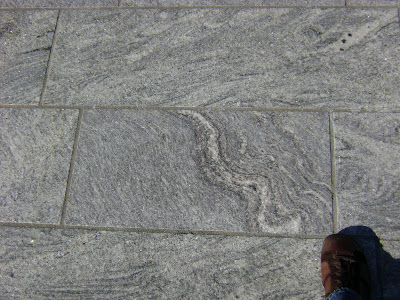 For the soft rock crowd, we have the plaza outside Faneuil Hall Marketplace, which claims to mark the original Boston Harbor shoreline. There are a lot of other strange little markings carved into the stones here - maybe someone from the crew of National Treasure got drunk and decided to add a few extra "clues" for the villains to follow.
For the soft rock crowd, we have the plaza outside Faneuil Hall Marketplace, which claims to mark the original Boston Harbor shoreline. There are a lot of other strange little markings carved into the stones here - maybe someone from the crew of National Treasure got drunk and decided to add a few extra "clues" for the villains to follow. The memorial was very haunting, but what also interested me were the construction materials. Here's an example of the stone used throughout:
The memorial was very haunting, but what also interested me were the construction materials. Here's an example of the stone used throughout: The memorial website says it's "black granite", which I suspect is more a building supply term than anything a geologist would recognize. Maybe some sort of diabase? I didn't think it would be respectful to be crouching next to it with a hand lens and a pocketknife, so I didn't look all that closely. If anyone can hazard a guess as to what "black granite" translates to, go for it.
The memorial website says it's "black granite", which I suspect is more a building supply term than anything a geologist would recognize. Maybe some sort of diabase? I didn't think it would be respectful to be crouching next to it with a hand lens and a pocketknife, so I didn't look all that closely. If anyone can hazard a guess as to what "black granite" translates to, go for it.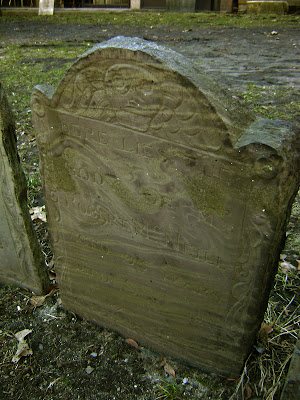 The Granary Burying Ground has some witty commentary in granite.
The Granary Burying Ground has some witty commentary in granite.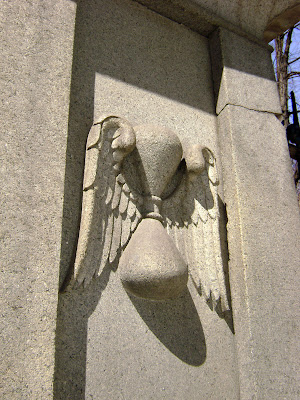 Finally, a contribution to the Airliner Chronicles. This is shortly after takeoff, looking down on some mosquito ditches in a salt marsh. Mosquito ditches were dug into marshes in the Colonial period to drain standing water and sometimes to mark property lines. In later times, particularly after the Civil War, when soldiers were bringing home malaria, they were dug to control the mosquito populations. One of my undergrad classmates did her senior thesis on the effects of these ditches on tidal flux, and apparently many areas are removing them entirely, because they eliminate wetlands and affect the volume of fresh water that reaches the salt marshes.
Finally, a contribution to the Airliner Chronicles. This is shortly after takeoff, looking down on some mosquito ditches in a salt marsh. Mosquito ditches were dug into marshes in the Colonial period to drain standing water and sometimes to mark property lines. In later times, particularly after the Civil War, when soldiers were bringing home malaria, they were dug to control the mosquito populations. One of my undergrad classmates did her senior thesis on the effects of these ditches on tidal flux, and apparently many areas are removing them entirely, because they eliminate wetlands and affect the volume of fresh water that reaches the salt marshes. 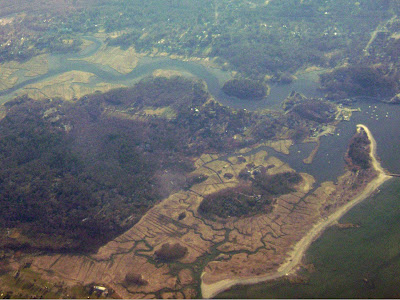
"That evacuation included the Volcano House hotel within the park, with guests at the hotel moved to the Naniloa Volcanoes Resort in Hilo, [Big Island Mayor Harry] Kim said. He said staffing at the park would be limited to required personnel only.Here's another comment from Kim in the AP:
Civil defense officials at 9 p.m. last night announced voluntary evacuations for five communities northeast of Halema'uma'u crater as sulfur dioxide fumes in the area are expected to intensify today.
The voluntary evacuation advisory covered the Mauna Loa Estates, Ohia Estates and Volcano Golf Course subdivisions as well as the Volcano Village and Keauhou Ranch areas."
"As far as we know the number was light because the sulfur dioxide levels really did not materialize to the degree that was much anticipated," Hawaii County Mayor Harry Kim said. "What did happen during the day is that we did have some ... brief periods of high levels of sulfur dioxide in the affected areas, mainly in the national park areas."Vog is nasty stuff. Usually it's Kona that has the most problems with it, enough so that they put out daily advisories of vog levels, much like air quality notices or pollen counts on the mainland. On my trips, it was barely noticeable, which was quite lucky - although that's not to say that I didn't have encounters with volcanic gases.
 I spent a lot of time up in the North End, the "Little Italy" area, where everyone has that wonderful Italian sense of humor.
I spent a lot of time up in the North End, the "Little Italy" area, where everyone has that wonderful Italian sense of humor.
